VOLVO 240 1990 Owners Manual
Manufacturer: VOLVO, Model Year: 1990, Model line: 240, Model: VOLVO 240 1990Pages: 143, PDF Size: 2.32 MB
Page 91 of 143
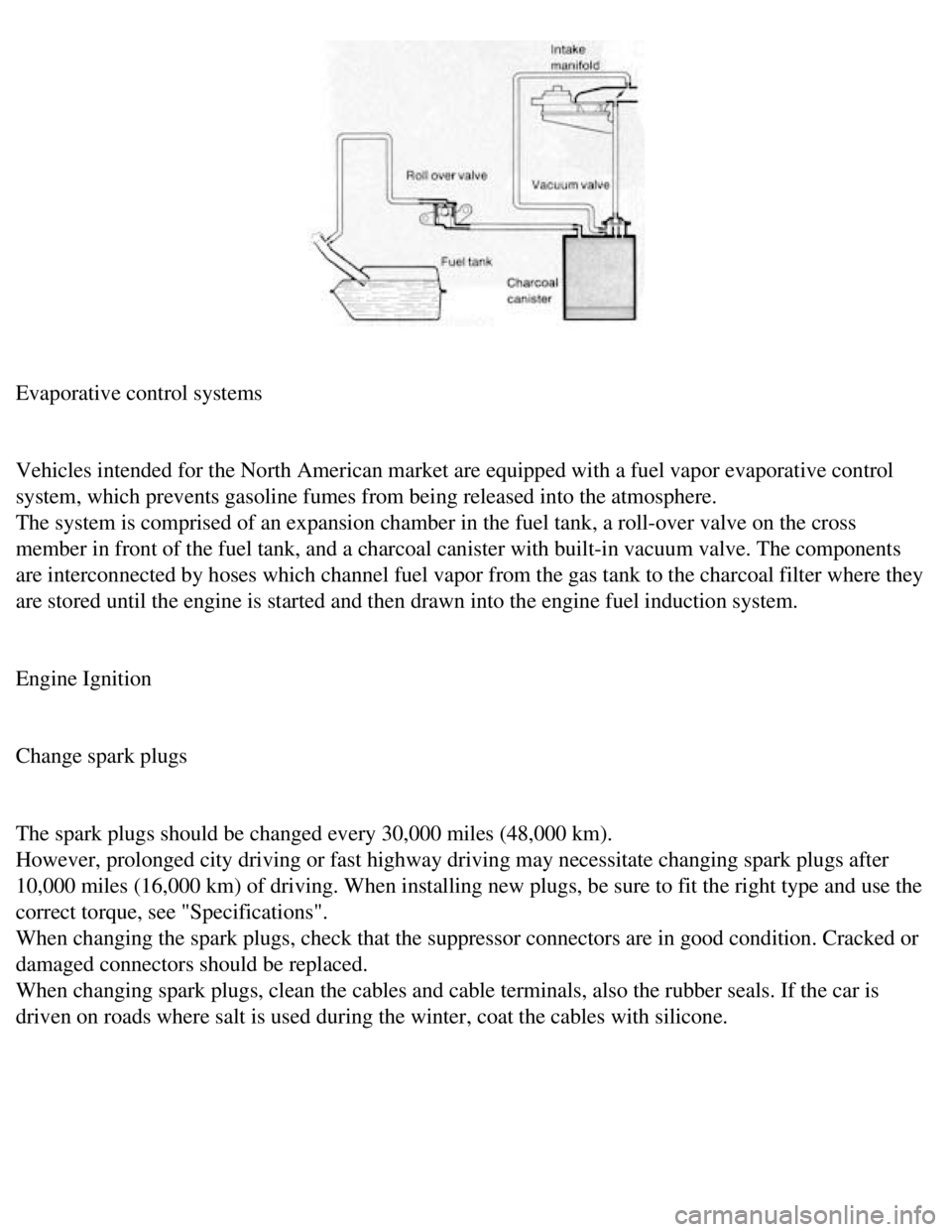
Volvo 1990 240 Model
Evaporative control systems
Vehicles intended for the North American market are equipped with a fuel\
vapor evaporative control
system, which prevents gasoline fumes from being released into the atmos\
phere.
The system is comprised of an expansion chamber in the fuel tank, a roll\
-over valve on the cross
member in front of the fuel tank, and a charcoal canister with built-in \
vacuum valve. The components
are interconnected by hoses which channel fuel vapor from the gas tank t\
o the charcoal filter where they
are stored until the engine is started and then drawn into the engine fu\
el induction system.
Engine Ignition
Change spark plugs
The spark plugs should be changed every 30,000 miles (48,000 km).
However, prolonged city driving or fast highway driving may necessitate \
changing spark plugs after
10,000 miles (16,000 km) of driving. When installing new plugs, be sur\
e to fit the right type and use the
correct torque, see "Specifications".
When changing the spark plugs, check that the suppressor connectors are \
in good condition. Cracked or
damaged connectors should be replaced.
When changing spark plugs, clean the cables and cable terminals, also th\
e rubber seals. If the car is
driven on roads where salt is used during the winter, coat the cables wi\
th silicone.
file:///K|/ownersdocs/1990/1990_240/90240_14.htm (6 of 7)12/30/2006 8:\
25:08 AM
Page 92 of 143
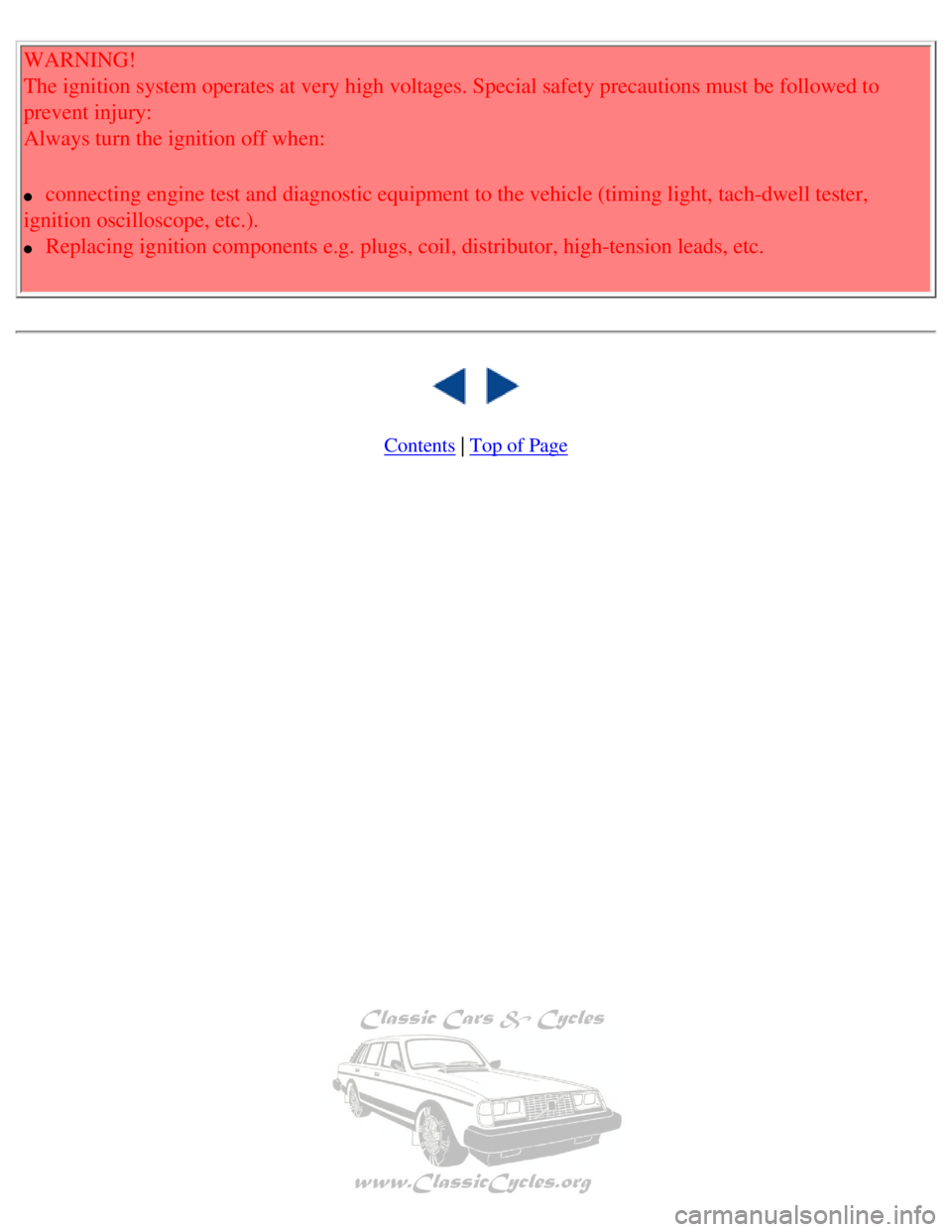
Volvo 1990 240 Model
WARNING!
The ignition system operates at very high voltages. Special safety preca\
utions must be followed to
prevent injury:
Always turn the ignition off when:
l connecting engine test and diagnostic equipment to the vehicle (timing \
light, tach-dwell tester,
ignition oscilloscope, etc.).
l Replacing ignition components e.g. plugs, coil, distributor, high-tensio\
n leads, etc.
Contents | Top of Page
file:///K|/ownersdocs/1990/1990_240/90240_14.htm (7 of 7)12/30/2006 8:\
25:08 AM
Page 93 of 143
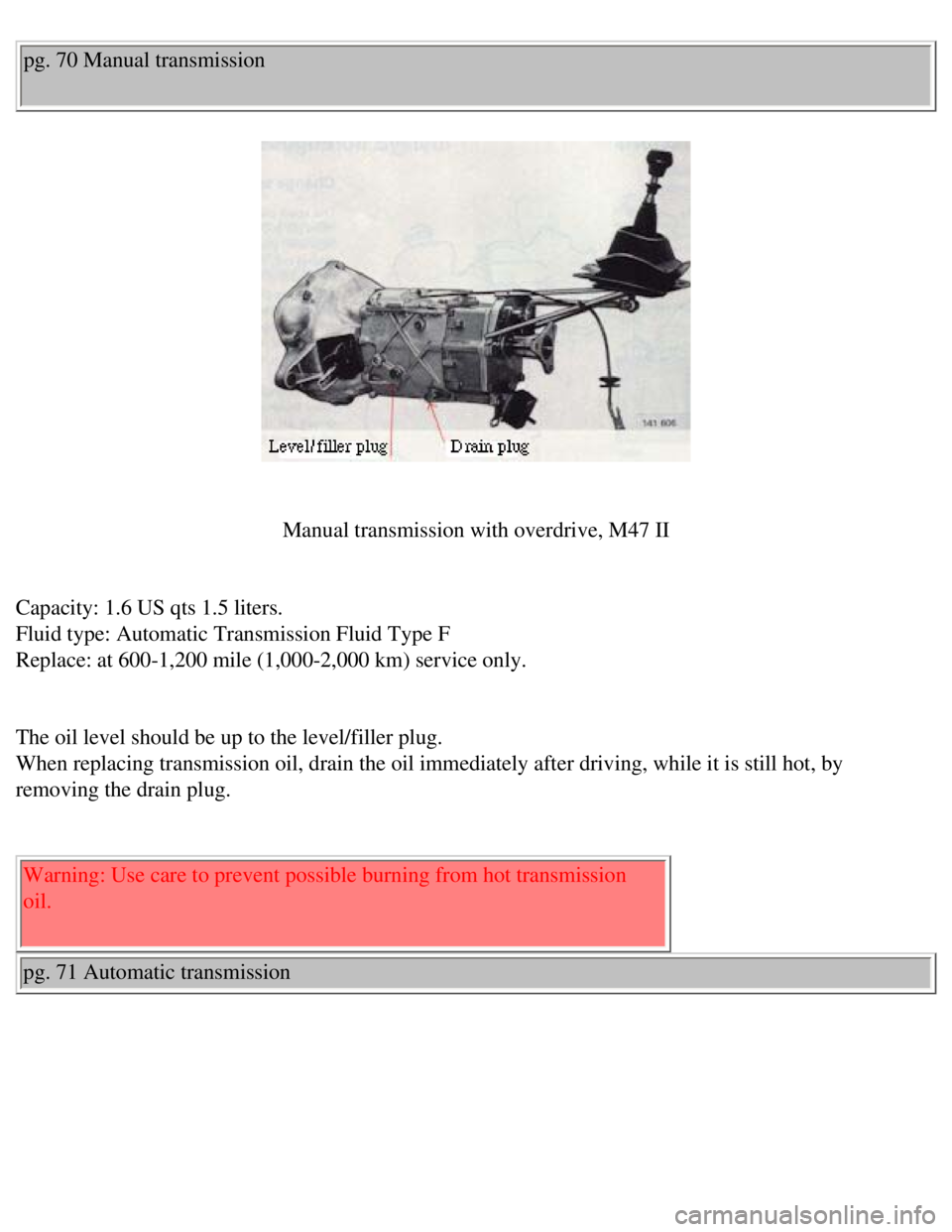
Volvo 1990 240 Model
pg. 70 Manual transmission
Manual transmission with overdrive, M47 II
Capacity: 1.6 US qts 1.5 liters.
Fluid type: Automatic Transmission Fluid Type F
Replace: at 600-1,200 mile (1,000-2,000 km) service only.
The oil level should be up to the level/filler plug.
When replacing transmission oil, drain the oil immediately after driving\
, while it is still hot, by
removing the drain plug.
Warning: Use care to prevent possible burning from hot transmission
oil.
pg. 71 Automatic transmission
file:///K|/ownersdocs/1990/1990_240/90240_15.htm (1 of 10)12/30/2006 8\
:25:09 AM
Page 94 of 143

Volvo 1990 240 Model
Automatic transmission
Capacity: 7.8 US qts (7.4 liters)
Fluid type: Automatic Transmission Fluid type Dexron II D.
Replace: every 20,000 miles (32,000 km).
A Cold transmission: oil temperature = + 105°F ( + 40°C) .
This is a normal temperature for the transmission after idling for about\
10 minutes.
At oil temperature below +105°F (+40°C), the level may be below \
the MIN mark.
B Warm transmission: oil temperature = + 195°F ( + 90°C) .
This temperature is obtained when driving for about 30 minutes.
At oil temperature above + 195°F ( + 90°C), the level may be abo\
ve the MAX mark.
Note!
The engine should be idling when checking transmission fluid
level.
Check the oil level as follows:
Park the car on level surface with the engine idling.
Slowly move the selector lever through all the gear positions and then t\
o position P. Wait 2 minutes
before checking the oil level. As the illustration shows, the dipstick h\
as a "Cold" and a "warm" side.
The oil level should be between the MIN and MAX marks.
Wipe the dipstick with a clean cloth.
file:///K|/ownersdocs/1990/1990_240/90240_15.htm (2 of 10)12/30/2006 8\
:25:09 AM
Page 95 of 143
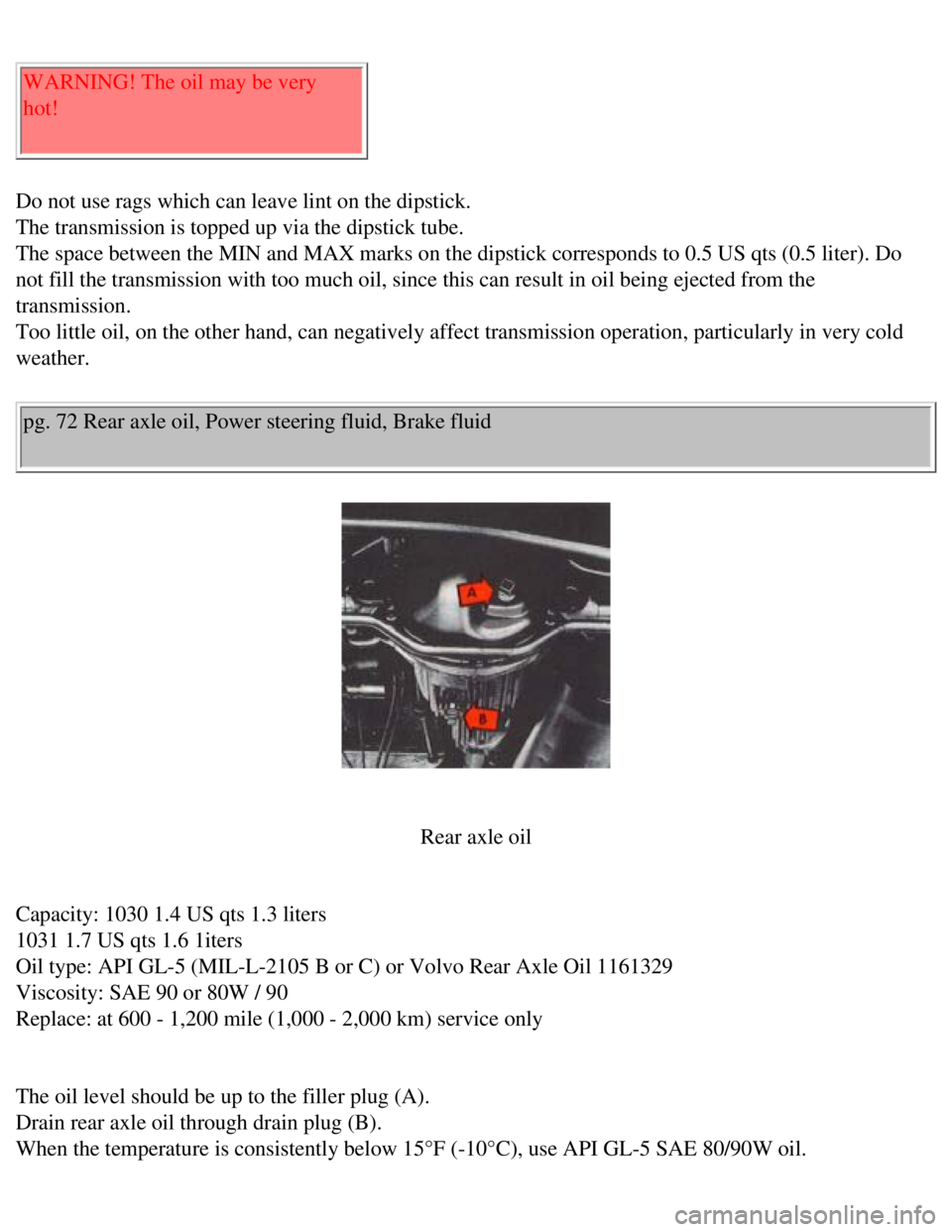
Volvo 1990 240 Model
WARNING! The oil may be very
hot!
Do not use rags which can leave lint on the dipstick.
The transmission is topped up via the dipstick tube.
The space between the MIN and MAX marks on the dipstick corresponds to 0\
.5 US qts (0.5 liter). Do
not fill the transmission with too much oil, since this can result in oi\
l being ejected from the
transmission.
Too little oil, on the other hand, can negatively affect transmission op\
eration, particularly in very cold
weather.
pg. 72 Rear axle oil, Power steering fluid, Brake fluid
Rear axle oil
Capacity: 1030 1.4 US qts 1.3 liters
1031 1.7 US qts 1.6 1iters
Oil type: API GL-5 (MIL-L-2105 B or C) or Volvo Rear Axle Oil 1161329 \
Viscosity: SAE 90 or 80W / 90
Replace: at 600 - 1,200 mile (1,000 - 2,000 km) service only
The oil level should be up to the filler plug (A).
Drain rear axle oil through drain plug (B).
When the temperature is consistently below 15°F (-10°C), use API\
GL-5 SAE 80/90W oil.
file:///K|/ownersdocs/1990/1990_240/90240_15.htm (3 of 10)12/30/2006 8\
:25:09 AM
Page 96 of 143
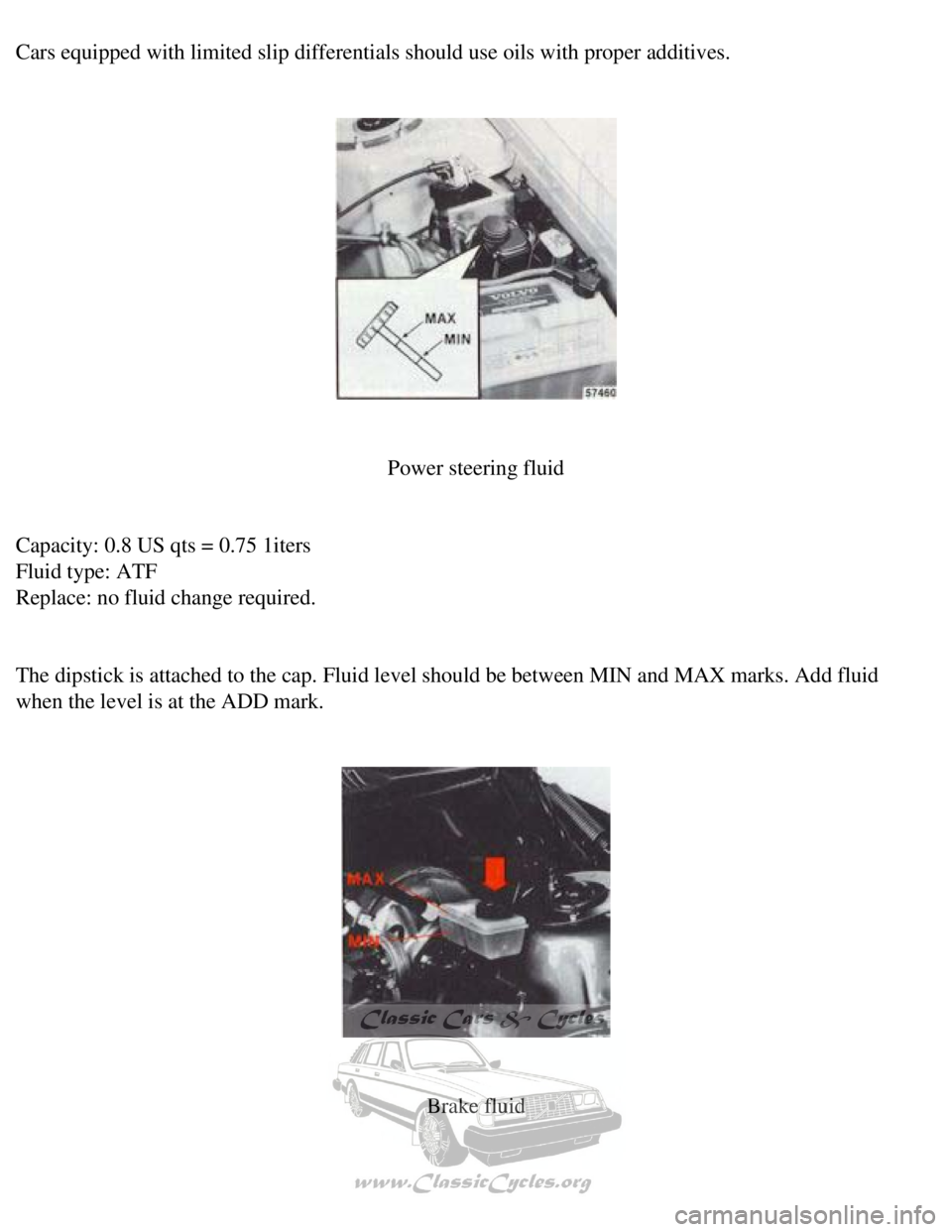
Volvo 1990 240 Model
Cars equipped with limited slip differentials should use oils with prope\
r additives.
Power steering fluid
Capacity: 0.8 US qts = 0.75 1iters
Fluid type: ATF
Replace: no fluid change required.
The dipstick is attached to the cap. Fluid level should be between MIN a\
nd MAX marks. Add fluid
when the level is at the ADD mark.
Brake fluid
file:///K|/ownersdocs/1990/1990_240/90240_15.htm (4 of 10)12/30/2006 8\
:25:09 AM
Page 97 of 143
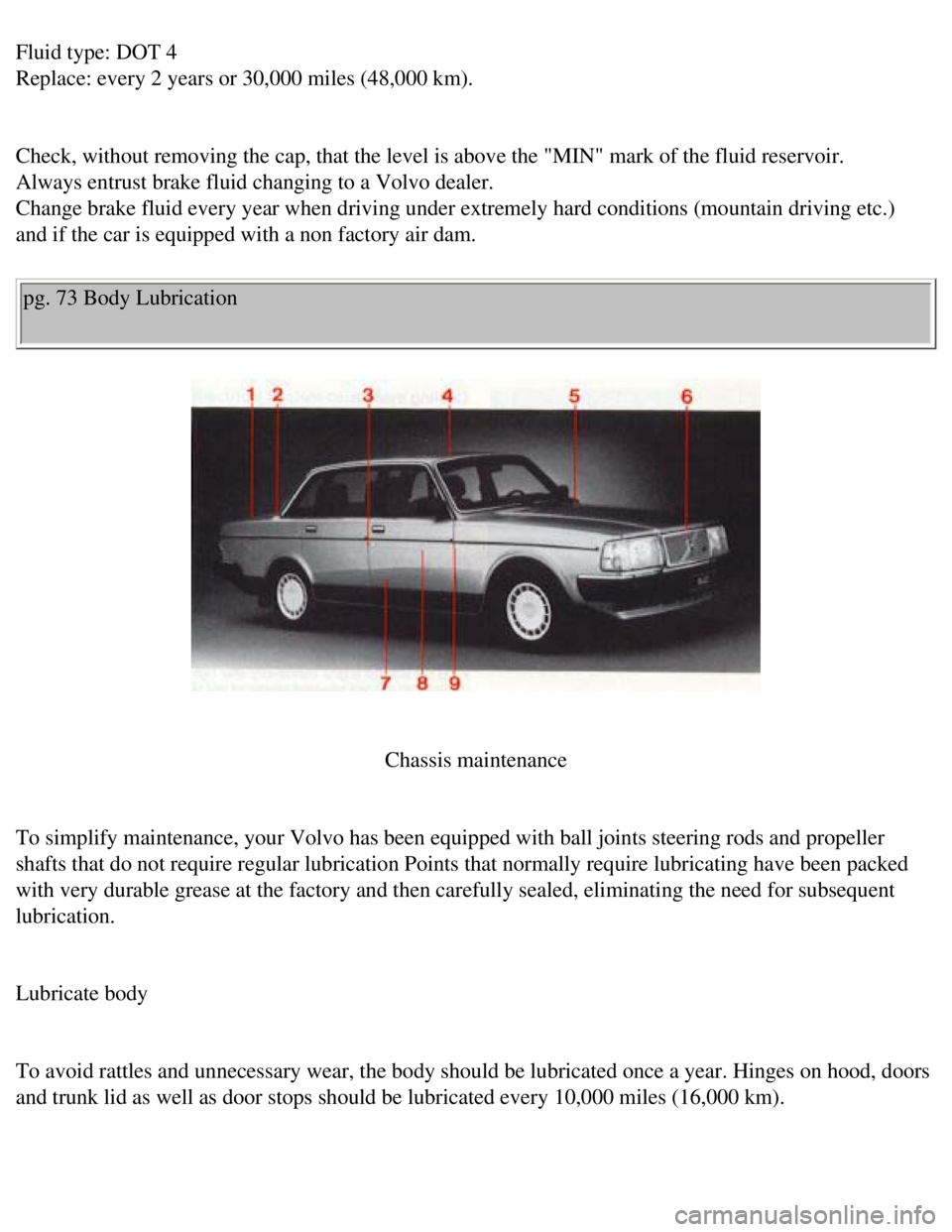
Volvo 1990 240 Model
Fluid type: DOT 4
Replace: every 2 years or 30,000 miles (48,000 km).
Check, without removing the cap, that the level is above the "MIN" mark \
of the fluid reservoir.
Always entrust brake fluid changing to a Volvo dealer.
Change brake fluid every year when driving under extremely hard conditio\
ns (mountain driving etc.)
and if the car is equipped with a non factory air dam. pg. 73 Body Lubrication
Chassis maintenance
To simplify maintenance, your Volvo has been equipped with ball joints s\
teering rods and propeller
shafts that do not require regular lubrication Points that normally requ\
ire lubricating have been packed
with very durable grease at the factory and then carefully sealed, elimi\
nating the need for subsequent
lubrication.
Lubricate body
To avoid rattles and unnecessary wear, the body should be lubricated onc\
e a year. Hinges on hood, doors
and trunk lid as well as door stops should be lubricated every 10,000 mi\
les (16,000 km).
file:///K|/ownersdocs/1990/1990_240/90240_15.htm (5 of 10)12/30/2006 8\
:25:09 AM
Page 98 of 143
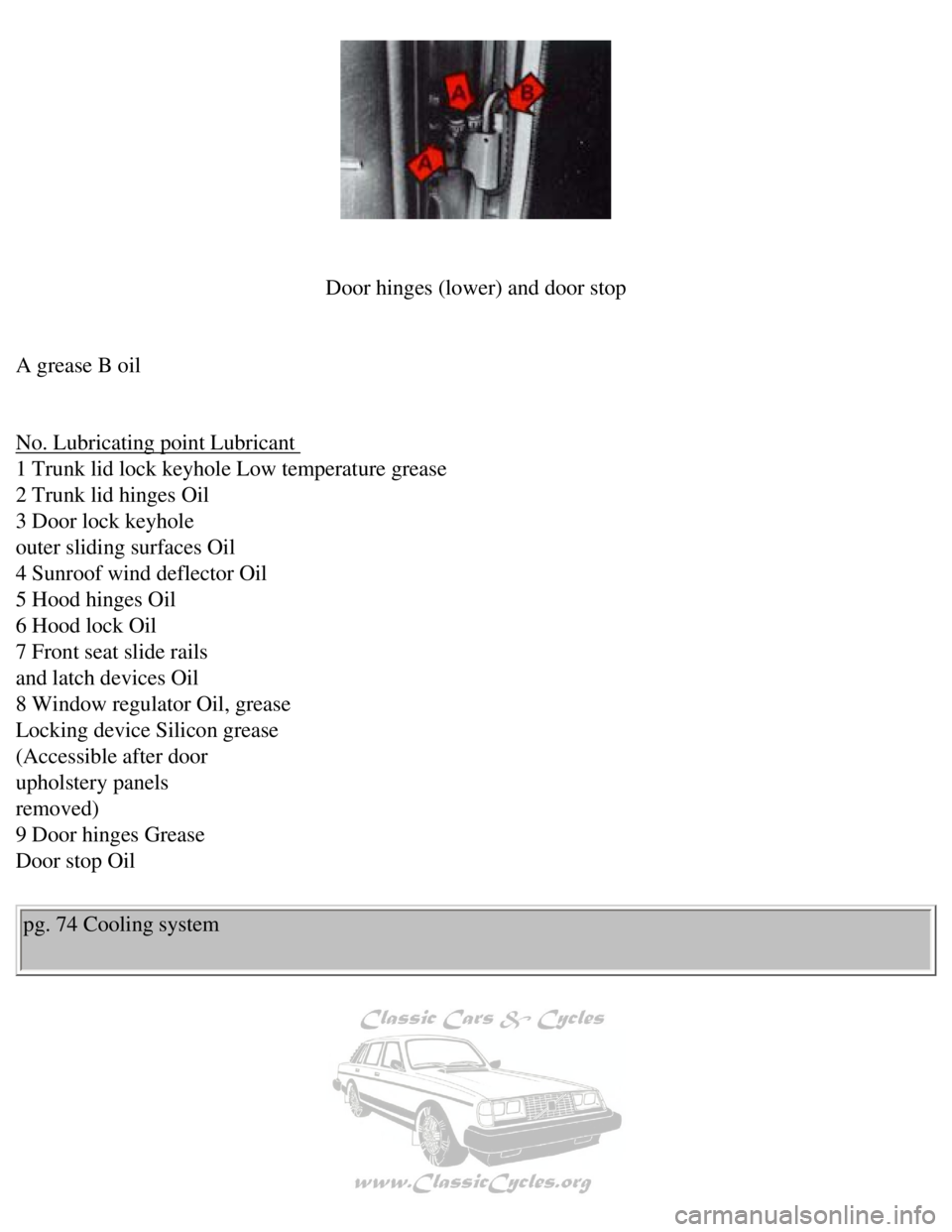
Volvo 1990 240 Model
Door hinges (lower) and door stop
A grease B oil
No. Lubricating point Lubricant
1 Trunk lid lock keyhole Low temperature grease
2 Trunk lid hinges Oil
3 Door lock keyhole
outer sliding surfaces Oil
4 Sunroof wind deflector Oil
5 Hood hinges Oil
6 Hood lock Oil
7 Front seat slide rails
and latch devices Oil
8 Window regulator Oil, grease
Locking device Silicon grease
(Accessible after door
upholstery panels
removed)
9 Door hinges Grease
Door stop Oil
pg. 74 Cooling system
file:///K|/ownersdocs/1990/1990_240/90240_15.htm (6 of 10)12/30/2006 8\
:25:09 AM
Page 99 of 143
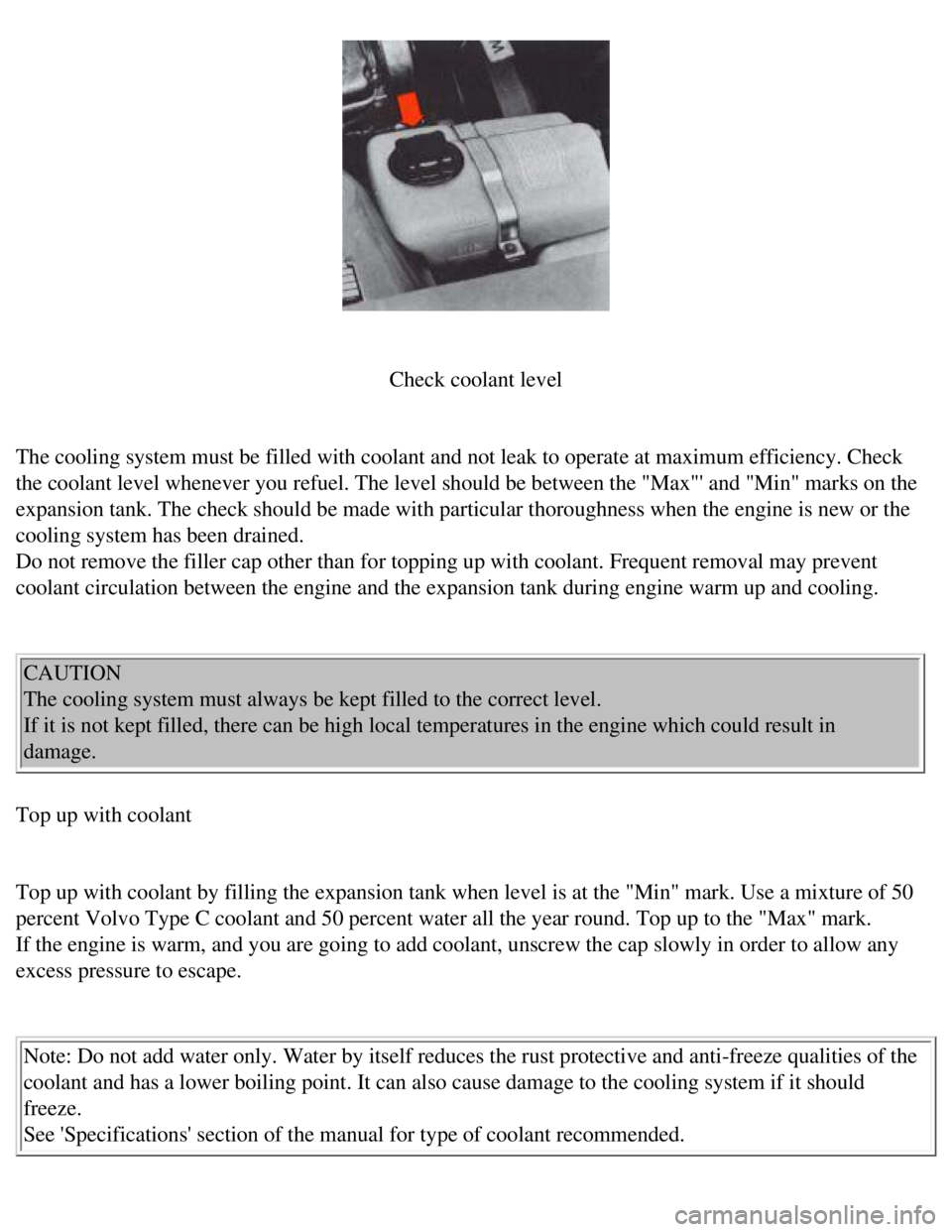
Volvo 1990 240 Model
Check coolant level
The cooling system must be filled with coolant and not leak to operate a\
t maximum efficiency. Check
the coolant level whenever you refuel. The level should be between the "\
Max"' and "Min" marks on the
expansion tank. The check should be made with particular thoroughness wh\
en the engine is new or the
cooling system has been drained.
Do not remove the filler cap other than for topping up with coolant. Fre\
quent removal may prevent
coolant circulation between the engine and the expansion tank during eng\
ine warm up and cooling.
CAUTION
The cooling system must always be kept filled to the correct level.
If it is not kept filled, there can be high local temperatures in the en\
gine which could result in
damage.
Top up with coolant
Top up with coolant by filling the expansion tank when level is at the "\
Min" mark. Use a mixture of 50
percent Volvo Type C coolant and 50 percent water all the year round. To\
p up to the "Max" mark.
If the engine is warm, and you are going to add coolant, unscrew the cap\
slowly in order to allow any
excess pressure to escape.
Note: Do not add water only. Water by itself reduces the rust protective\
and anti-freeze qualities of the
coolant and has a lower boiling point. It can also cause damage to the c\
ooling system if it should
freeze.
See 'Specifications' section of the manual for type of coolant recommend\
ed.
file:///K|/ownersdocs/1990/1990_240/90240_15.htm (7 of 10)12/30/2006 8\
:25:09 AM
Page 100 of 143
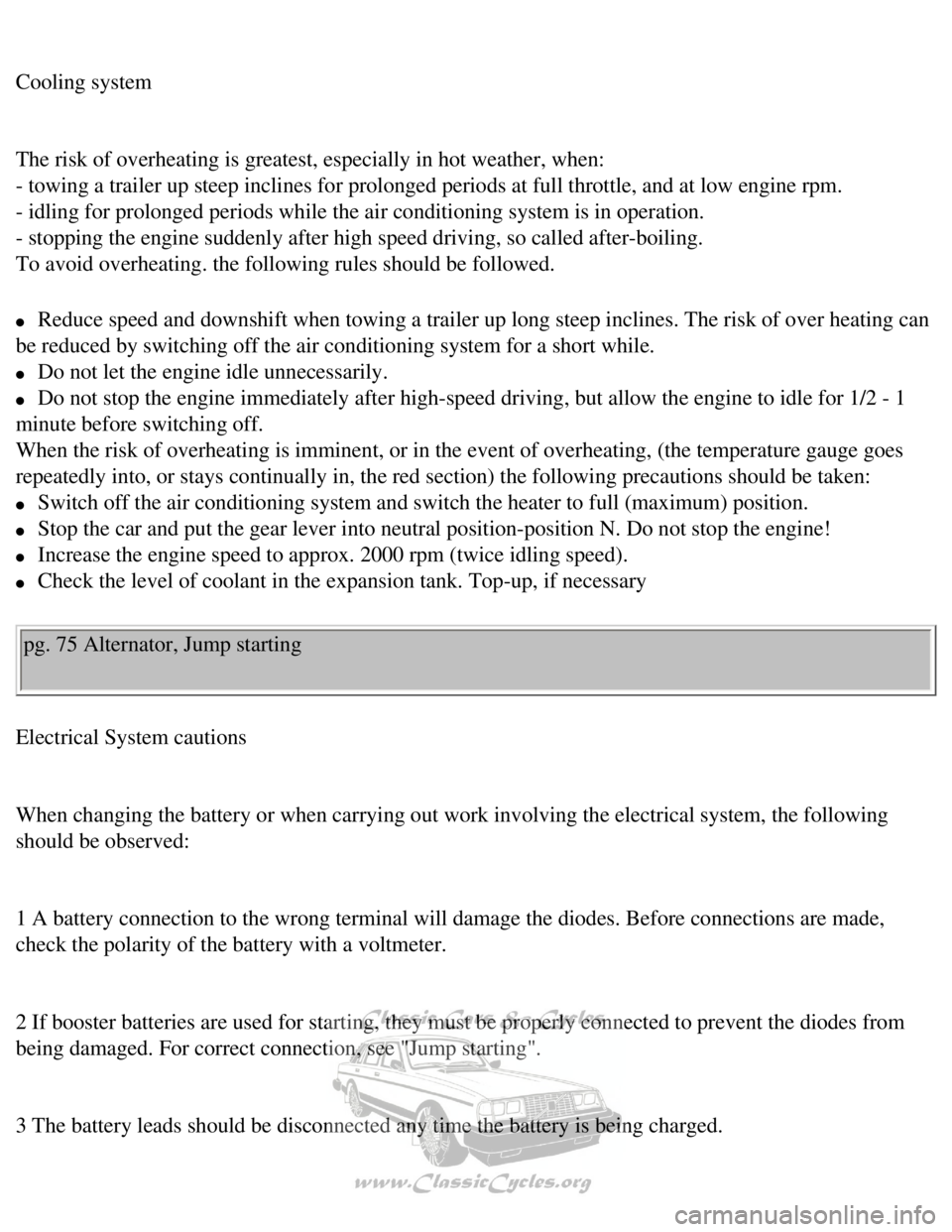
Volvo 1990 240 Model
Cooling system
The risk of overheating is greatest, especially in hot weather, when:
- towing a trailer up steep inclines for prolonged periods at full throt\
tle, and at low engine rpm.
- idling for prolonged periods while the air conditioning system is in o\
peration.
- stopping the engine suddenly after high speed driving, so called after\
-boiling.
To avoid overheating. the following rules should be followed.
l Reduce speed and downshift when towing a trailer up long steep inclines.\
The risk of over heating can
be reduced by switching off the air conditioning system for a short whil\
e.
l Do not let the engine idle unnecessarily.
l Do not stop the engine immediately after high-speed driving, but allow t\
he engine to idle for 1/2 - 1
minute before switching off.
When the risk of overheating is imminent, or in the event of overheating\
, (the temperature gauge goes
repeatedly into, or stays continually in, the red section) the followin\
g precautions should be taken:
l Switch off the air conditioning system and switch the heater to full (m\
aximum) position.
l Stop the car and put the gear lever into neutral position-position N. Do\
not stop the engine!
l Increase the engine speed to approx. 2000 rpm (twice idling speed).
l Check the level of coolant in the expansion tank. Top-up, if necessary
pg. 75 Alternator, Jump starting
Electrical System cautions
When changing the battery or when carrying out work involving the electr\
ical system, the following
should be observed:
1 A battery connection to the wrong terminal will damage the diodes. Bef\
ore connections are made,
check the polarity of the battery with a voltmeter.
2 If booster batteries are used for starting, they must be properly conn\
ected to prevent the diodes from
being damaged. For correct connection, see "Jump starting".
3 The battery leads should be disconnected any time the battery is being\
charged.
file:///K|/ownersdocs/1990/1990_240/90240_15.htm (8 of 10)12/30/2006 8\
:25:09 AM